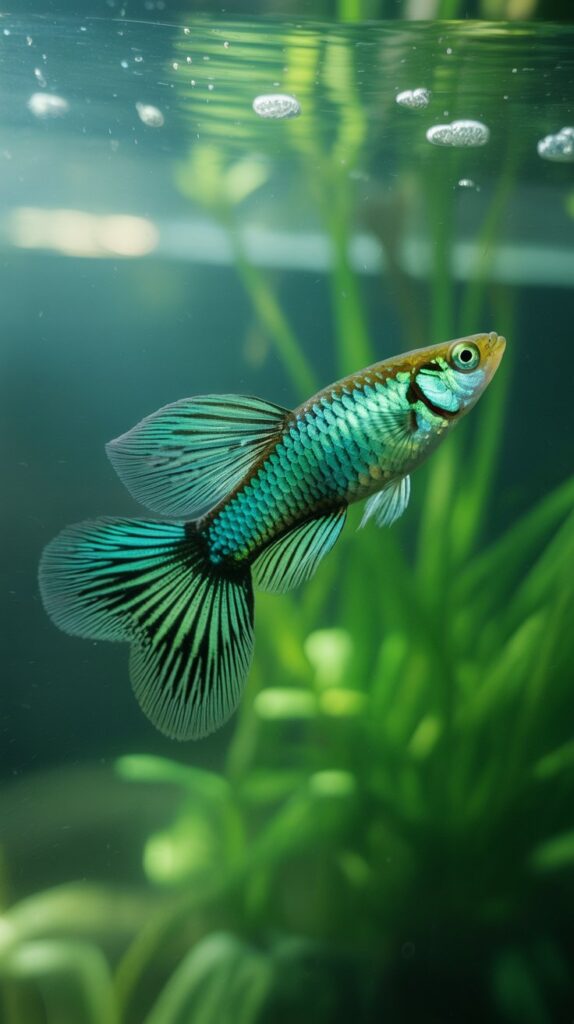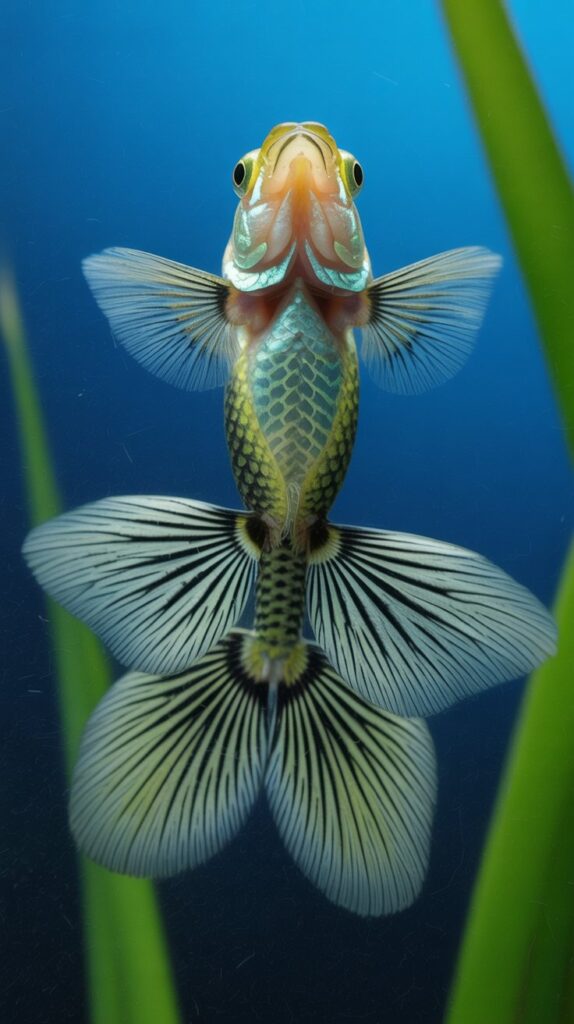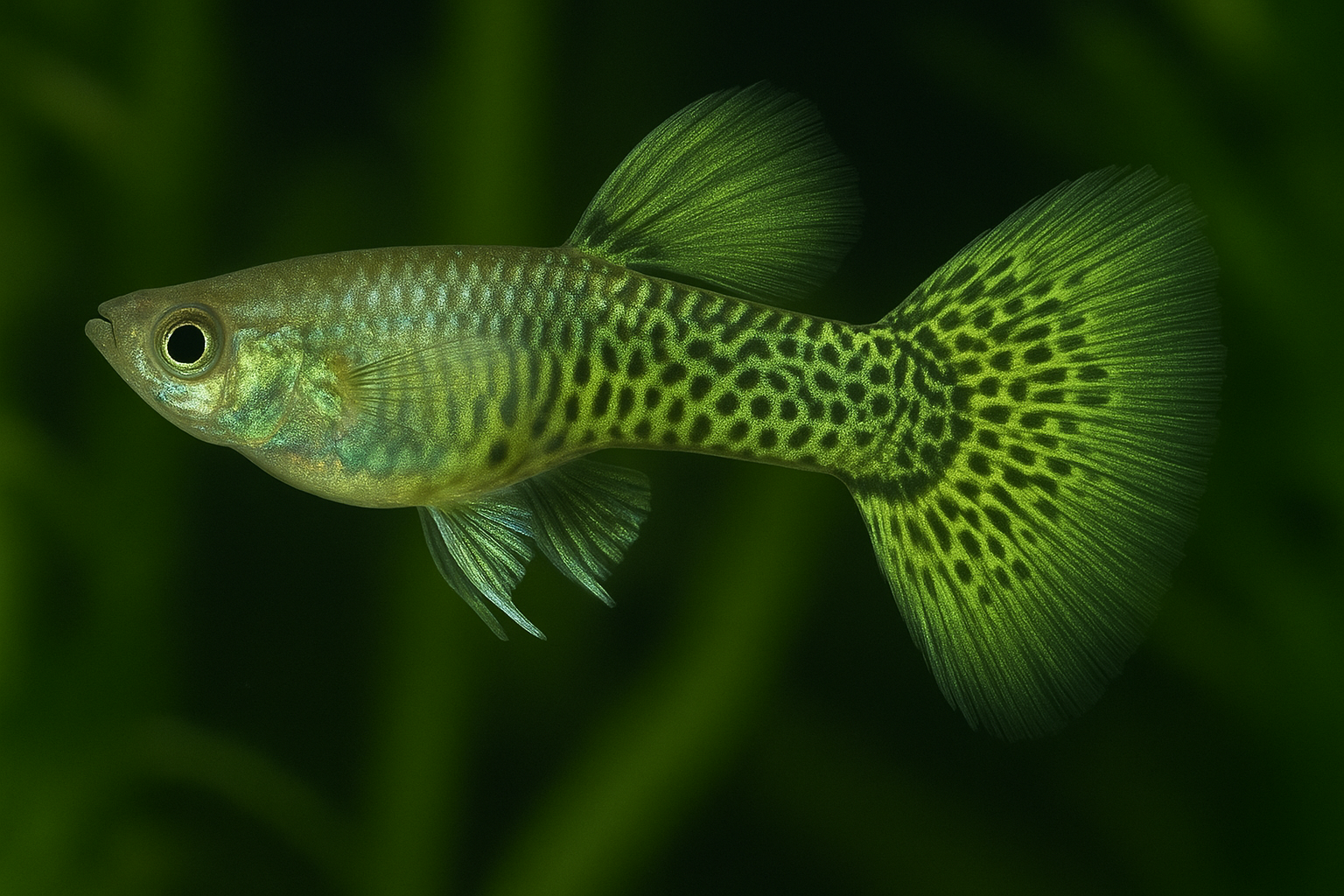The Green Snakeskin Guppy is one of the most striking and exotic guppy varieties in the ornamental fish world. Recognized for its intricate “snakeskin” pattern and vibrant green coloration, this guppy can transform any aquarium into a living piece of art. Its mix of elegance, hardiness, and active personality makes it an ideal choice for both beginner and seasoned aquarists.
In this complete guide, we’ll explore the origins, appearance, behavior, tank requirements, feeding habits, breeding tips, and health care for the Green Snakeskin Guppy. By the end, you’ll know exactly how to keep them healthy, happy, and thriving.
Origins and History of the Green Snakeskin Guppy
Guppies (Poecilia reticulata) originate from tropical freshwater rivers and streams in South America, particularly in Venezuela, Guyana, and Trinidad. The Green Snakeskin Guppy is not a naturally occurring species in the wild — it’s the result of selective breeding, developed by crossing snakeskin-patterned guppies with green or metallic strains to achieve a shimmering green body and intricate reticulated markings.
Over decades, aquarists refined the strain to enhance its unique pattern: a maze-like design resembling snake scales along its body and tail, combined with a bright green overlay that gleams under aquarium lighting.
Appearance and Characteristics

1. Body Color
The Green Snakeskin Guppy displays a dazzling combination of metallic green hues with a black lace-like “snakeskin” pattern covering most of its body and fins.
2. Fin Types
Available in a variety of fin shapes, such as:
- Delta tail
- Veil tail
- Round tail
- Ribbon tail
Some Green Snakeskin Guppies even have extended dorsal fins for extra flair.
3. Size
- Males: 1.5 – 2 inches (3.8 – 5 cm)
- Females: 2 – 2.5 inches (5 – 6.3 cm)
4. Sexual Dimorphism
- Males: More colorful, smaller, with longer, decorative fins.
- Females: Larger, less colorful, and with shorter fins.
Temperament and Behavior
Green Snakeskin Guppies are peaceful, active, and sociable. They thrive best in community tanks with other non-aggressive species. When kept in groups of six or more, they display better coloration and more natural behaviors.
Ideal Tank Mates
- Neon tetras
- Platies
- Swordtails
- Corydoras catfish
- Mollies
Tank Mates to Avoid
Avoid aggressive or fin-nipping fish like tiger barbs, large cichlids, or bettas.
Tank Requirements for Green Snakeskin Guppies

1. Tank Size
A minimum of 10 gallons is recommended for a small group, but a 20-gallon tank is ideal for stability and swimming space.
2. Water Parameters
- Temperature: 72°F – 82°F (22°C – 28°C)
- pH: 6.8 – 7.8
- Hardness: 8 – 12 dGH
- Ammonia/Nitrite: 0 ppm
- Nitrate: Below 20 ppm
3. Filtration
Use a sponge filter or hang-on-back filter to maintain water quality without creating too strong a current.
4. Lighting
Moderate lighting is perfect for showcasing the metallic green shine and intricate snakeskin pattern.
5. Substrate and Decor
- Substrate: Fine gravel or sand.
- Plants: Java moss, guppy grass, hornwort, and anubias provide hiding spots and breeding grounds.
- Decor: Driftwood, smooth stones, and caves to mimic a natural habitat.
Feeding and Nutrition
Green Snakeskin Guppies are omnivorous and require a balanced diet of plant-based and protein-rich foods.
Recommended Diet:
- High-quality flakes or pellets – Made for tropical fish.
- Live foods – Brine shrimp, mosquito larvae, and daphnia.
- Frozen foods – Bloodworms, mysis shrimp, tubifex worms.
- Vegetables – Blanched spinach, cucumber slices, or zucchini.
Feeding Tip: Offer food 2–3 times daily in small portions to prevent overfeeding and water pollution.
Breeding Green Snakeskin Guppies

Breeding guppies is one of the easiest and most rewarding aspects of the hobby. The Green Snakeskin Guppy is a livebearer, meaning the female gives birth to free-swimming fry.
1. Sex Ratio
Keep one male for every two or three females to reduce stress on the females.
2. Breeding Tank Setup
- Tank size: 5–10 gallons
- Temperature: 78°F (25.5°C)
- Dense plants or breeding grass for fry hiding spots
3. Gestation Period
Females carry fry for 21–30 days before giving birth.
4. Fry Care
- Separate fry from adults to avoid predation.
- Feed powdered fry food, infusoria, or newly hatched brine shrimp.
Health and Disease Prevention
Green Snakeskin Guppies are hardy but can be affected by common aquarium illnesses.
Common Diseases:
- Ich (White Spot Disease) – Treat with aquarium salt and medication.
- Fin Rot – Linked to poor water conditions; treat with antibacterial remedies.
- Velvet Disease – Caused by parasites; treat with copper-based medications.
- Swim Bladder Issues – Often diet-related; fasting for a day can help.
Prevention Tips:
- Maintain water quality.
- Quarantine new fish.
- Avoid overstocking.
Why Choose Green Snakeskin Guppies?

- Unique Pattern: Their intricate snakeskin markings are rare and eye-catching.
- Hardiness: They adapt to a wide range of conditions.
- Peaceful Nature: Perfect for community tanks.
- Prolific Breeders: Great for hobbyists looking to breed guppies.
- Affordability: Easily available at reasonable prices.
Maintenance Tips
- Weekly Water Changes: Replace 20–30% of water.
- Gravel Vacuuming: Remove debris and leftover food.
- Filter Cleaning: Rinse filter media in old tank water once a month.
- Water Testing: Check parameters weekly.
- Observation: Look for signs of stress or disease early.
Conclusion
The Green Snakeskin Guppy is a stunning addition to any aquarium, combining elegance with ease of care. With their vivid green hues, intricate patterns, and friendly disposition, they are ideal for aquarists of all skill levels. By providing them with the right tank conditions, balanced diet, and proper care, you can enjoy their beauty for years to come.
FAQs About Green Snakeskin Guppies
Q1: How long do Green Snakeskin Guppies live?
A: With good care, they typically live 2–3 years, sometimes longer.
Q2: Can I keep them with shrimp?
A: Yes, they are generally peaceful with shrimp, though small fry shrimp may be eaten.
Q3: How many Green Snakeskin Guppies can I keep in a 10-gallon tank?
A: Around 6 guppies, following the one-inch-per-gallon rule.
Q4: Do they need a heater?
A: Yes, especially if your room temperature is below 72°F.
Q5: How can I enhance their color?
A: Provide high-quality food, stable water conditions, and good lighting.
Q6: Can I breed them with other guppy types?
A: Yes, but the offspring will be mixed and may lose the pure Green Snakeskin pattern.

